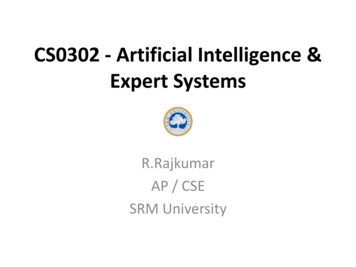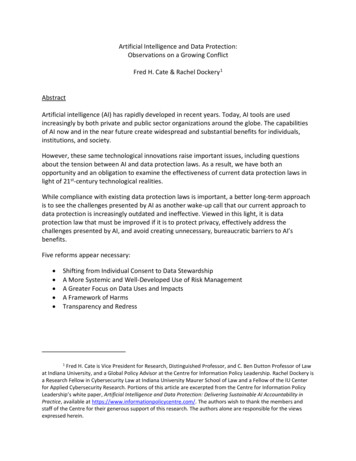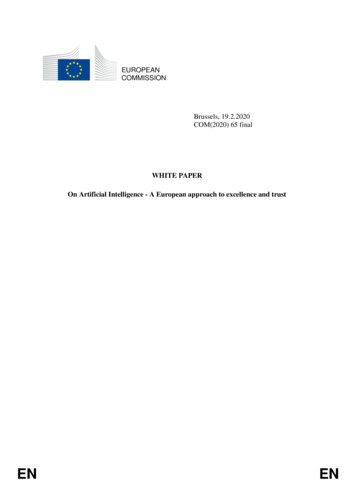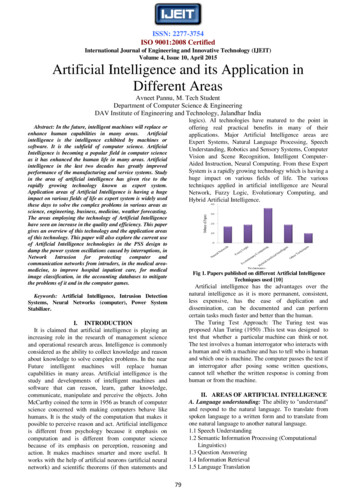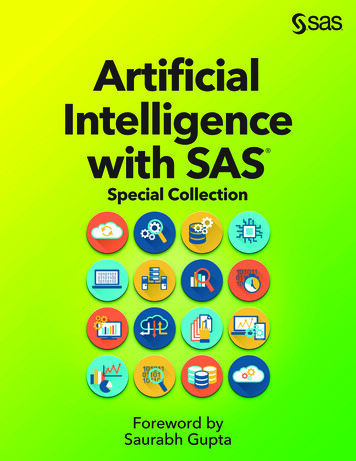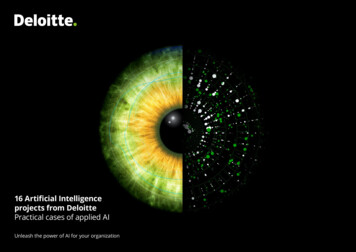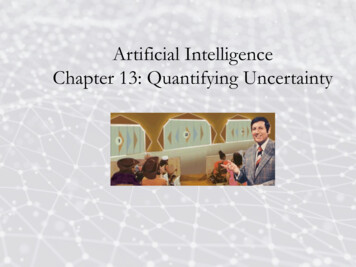
Transcription
Artificial IntelligenceChapter 13: Quantifying Uncertainty
JK
Digression: The Monty Hall Problem Suppose you're on a game show, and you're given the choice ofthree doors:Behind one door is a car; behind the others, goats.You pick a door, say No. 1, and the host, who knows what's behindthe doors, opens another door, say No. 3, which has a goat. He thensays to you, "Do you want to pick door No. 2?" Is it to your advantageto switch your choice?
Digression: The Monty Hall Problem
Digression: The Monty Hall Problem
Uncertainty Agents need to handle uncertainty, whether due to partialobservability, non-determinism, or a combination of the two. In Chapter 4, we encountered problem-solving agents designedto handle uncertainty by monitoring a belief-state – arepresentation of the set of all possible world states in whichthe agent might find itself (e.g. AND-OR graphs). The agent generated a contingency plan that handles everypossible eventuality that its sensors report during execution.
Uncertainty Despite its many virtues, however, this approach has manysignificant drawbacks:(*) With partial information, an agent must consider everypossible eventuality, no matter how unlikely. This leads toimpossibly large and complex belief-state representations.(*) A correct contingency plan that handles every possibleoutcome can grow arbitrarily large and must consider arbitrarilyunlikely contingencies.(*) Sometimes there is, in fact, no plan that is guaranteed toachieve a stated goal – yet the agent must act. It must have someway to compare the merits of plans that are not guaranteed.
UncertaintyLet action At leave for airport t minutes before flightWill At get me there on time?Problems:1.2.3.4.Partial observability (road state, other drivers' plans, etc.)Noisy sensors (traffic reports)Uncertainty in action outcomes (flat tire, etc.)Immense complexity of modeling and predicting trafficHence a purely logical approach either1. risks falsehood: “A25 will get me there on time”, or2. leads to conclusions that are too weak for decision making:“A25 will get me there on time if there's no accident on the bridge and it doesn'train and my tires remain intact etc etc.”(A1440 might reasonably be said to get me there on time but I'd have to stayovernight in the airport )
Uncertainty Consider a trivial example of uncertain reasoning for medicaldiagnosis.(*) Toothache Cavity (this is faulty)Me amend it:(*) Tootache Cavity V Gum Problem V Abscess Problem is that we would need to add an almost unlimited list ofpossible symptoms. We could instead attempt to turn the rule into a causal rule.(*) Cavity Tootache (this is also incorrect; not all cavitiescause pain).
Uncertainty The only way to fix the rule, it seems, is to make it logicallyexhaustive! (i.e. augment the left-hand side with all thequalifications required for a cavity to cause a toothache). This approach though naturally fails for at least (3) reasons:(1) Laziness: far too much work is required to compile theentire list.(2) Theoretical Ignorance: Medical science is theoreticallyincomplete.(3) Practical Ignorance: Even if we knew all the rules, wemight be uncertain about a particular patient, because not all ofthe necessary tests have been run.
Uncertainty Typically, an agent’s knowledge can at best provide only adegree of belief. Our main tool for dealing with degrees of belief is probabilitytheory. Probability provides a way of summarizing the uncertainty thatcomes from our laziness and ignorance.
Uncertainty and Rational Decisions So how best can an agent make rational decisions in the face ofuncertainty? To make choices, the agent must first have preferencesbetween possible outcomes of the various plans. An outcome is a completely specified state, including suchfactors as whether the agent arrives on time (e.g. the “airportproblem”). We use utility theory to represent reason with preferences.Utility theory asserts that every state has a degree of usefulness,or utility, to an agent and that the agent will prefer states withhigher utility.
Uncertainty and Rational Decisions Preferences, as expressed by utilities, are combined withprobabilities in the general theory of rational decisions calleddecision theory:Decision Theory Probability Theory Utility Theory Fundamental idea: an agent is rational iff it chooses the action thatyields the highest expected utility, averaged over all possible outcomes of theaction. (The principle of maximum expected utility (MEU)). Note that this is none other than a computation of expectedvalue.
ProbabilityProbabilistic assertions summarize effects of– laziness: failure to enumerate exceptions, qualifications, etc.– ignorance: lack of relevant facts, initial conditions, etc.Subjective probability: Probabilities relate propositions to agent's own state ofknowledgee.g., P(A25 no reported accidents) 0.06These are not assertions about the worldProbabilities of propositions change with new evidence:e.g., P(A25 no reported accidents, 5 a.m.) 0.15
Making decisions under uncertaintySuppose I believe the following:P(A25 gets me there on time )P(A90 gets me there on time )P(A120 gets me there on time )P(A1440 gets me there on time ) 0.04 0.70 0.95 0.9999 Which action to choose? Depends on my preferences for missing flight vs. time spentwaiting, etc.– Utility theory is used to represent and infer preferences– Decision theory probability theory utility theory
Syntax Basic element: random variable Similar to propositional logic: possible worlds defined by assignment of values torandom variables. Boolean random variablese.g., Cavity (do I have a cavity?) Discrete random variablese.g., Weather is one of sunny,rainy,cloudy,snow Domain values must be exhaustive and mutually exclusive Elementary proposition constructed by assignment of a value to arandom variable: e.g., Weather sunny, Cavity false(abbreviated as cavity) Complex propositions formed from elementary propositions and standard logicalconnectives e.g., Weather sunny Cavity false
Syntax Atomic event: A complete specification of the state ofthe world about which the agent is uncertain E.g., if the world consists of only two Boolean variables Cavityand Toothache, then there are 4 distinct atomic events:Cavity false Toothache falseCavity false Toothache trueCavity true Toothache falseCavity true Toothache true Atomic events are mutually exclusive and exhaustive
Axioms of probability The set of all possible “worlds” is the samplespace (omega). The possible worlds are mutuallyexclusive and exhaustive. A fully specified probability model associates a numericalprobability P(ω) with each possible world (we assumediscrete, countable worlds).0 P 1 for every , andP w 1
Axioms of probability Probabilistic assertions are usually about sets instead ofparticular possible worlds. These sets are commonly referred to as events. In AI, the sets are described by propositions in a formallanguage. The probability associated with a proposition isdefined to be the sum of probabilities of the worlds inwhich it holds:For any proposition , P P
Axioms of probability Probabilistic assertions are usually about sets instead ofparticular possible worlds. These sets are commonly referred to as events. In AI, the sets are described by propositions in a formallanguage. The probability associated with a proposition isdefined to be the sum of probabilities of the worlds inwhich it holds:For any proposition , P P
Axioms of probability The basic axioms of probability imply certain relationshipsamong the degrees of belief that can be accorded tologically-related propositions. Example:P a P a P P P a aP P 1 P a a a
Axioms of probability Inclusion-Exclusion (probability of a disjunction):P a b P a P b P a b Now derive the general formula for three or moresets
Axioms of probability Inclusion-Exclusion (probability of a disjunction):P a b P a P b P a b Now derive the general formula for three or moresets
Prior probability Prior or unconditional probabilities of propositionse.g., P(Cavity true) 0.1 and P(Weather sunny) 0.72 correspond to belief prior to arrivalof any (new) evidence Probability distribution gives values for all possible assignments:P(Weather) 0.72,0.1,0.08,0.1 (normalized, i.e., sums to 1) Joint probability distribution for a set of random variables gives the probability ofevery atomic event on those random variables P(Weather,Cavity) a 4 2 matrix of values:Weather Cavity trueCavity false 020.08Every question about a domain can be answered by the joint distribution
Conditional probability Conditional or posterior probabilitiese.g., P(cavity toothache) 0.8i.e., given that toothache is all I know (Notation for conditional distributions:P(Cavity Toothache) 2-element vector of 2-element vectors) If we know more, e.g., cavity is also given, then we haveP(cavity toothache,cavity) 1 New evidence may be irrelevant, allowing simplification, e.g.,P(cavity toothache, sunny) P(cavity toothache) 0.8 This kind of inference, sanctioned by domain knowledge, is crucial
Conditional probability Definition of conditional probability: P(a b) P(a b) / P(b) if P(b) 0 Product rule gives an alternative formulation: P(a b) P(a b) P(b) P(b a) P(a) A general version holds for whole distributions, e.g., P(Weather,Cavity) P(Weather Cavity) P(Cavity) (View as a set of 4 2 equations, not matrix mult.) Chain rule is derived by successive application of product rule: P(X1, ,Xn) P(X1,.,Xn-1) P(Xn X1,.,Xn-1) P(X1,.,Xn-2) P(Xn-1 X1,.,Xn-2) P(Xn X1,.,Xn-1) πi 1 n P(Xi X1, ,Xi-1)
Bayesian and Frequentist Probability (2) General paradigms for statistics and statistical inference: frequentist vs. Bayesian. Frequentists: Parameters are fixed; there is a (Platonic) model; parameters remain constant. Bayesians: Data are fixed; data are observed from realized sample; we encode prior beliefs;parameters are described probabilistically. Frequentists commonly use the MLE (maximum likelihood estimate) as a cogent point estimateof the model parameters of a probability distribution: Using the Law of Large Numbers (LLN),one can consequently show that:Potential issues with frequentist approach: philosophical reliance on long-term ‘frequencies’, theproblem of induction (Hume) and the black swan paradox, as well as the presence of limited exactsolutions for a small class of settings.
Bayesian and Frequentist ProbabilityIn the Bayesian framework, conversely, probability is regarded as a measure of uncertaintypertaining to the practitioner’s knowledge about a particular phenomenon.The prior belief of the experimenter is not ignored but rather encoded in the process ofcalculating probability.As the Bayesian gathers new information from experiments, this information is used, inconjunction with prior beliefs, to update the measure of certainty related to a specific outcome.These ideas are summarized elegantly in the familiar Bayes’ Theorem:Where H here connotes ‘hypothesis’ and D connotes ‘data’; the leftmost probability is referred toas the posterior (of the hypothesis), and the numerator factors are called the likelihood (of thedata) and the prior (on the hypothesis), respectively; the denominator expression is referred toas the marginal likelihood.Typically, the point estimate for a parameter used in Bayesian statistics is the mode of theposterior distribution, known as the maximum a posterior (MAP) estimate, which is given as:
Practice Problems(1) Derive Inclusion-Exclusion from Equations (13.1) and (13.2) in the text.(13.1)(13.2)(2) Consider the set of all possible five-card poker hands dealt fairly (i.e. randomly) from asingle, standard deck.(i) How many atomic events are there in the joint probability distribution?(ii) What is the probability of each atomic event?(iii) What is the probability of being dealt a royal flush?(iv) Four of a kind?(v) Given that my first two cards are aces, what is the probability that my total hand consistsof four aces?
Inference by enumeration Start with the joint probability distribution: For any proposition φ, sum the atomic events where it is true:
Inference by enumeration Start with the joint probability distribution: For any proposition φ, sum the atomic events where it is true: P(toothache) 0.108 0.012 0.016 0.064 0.2
Inference by enumeration Start with the joint probability distribution: Can also compute conditional probabilities: P( cavity toothache) P( cavity toothache)P(toothache) 0.016 0.0640.108 0.012 0.016 0.064 0.4
Normalization Denominator can be viewed as a normalization constant α P(Cavity toothache) α, P(Cavity,toothache) α, [P(Cavity,toothache,catch) P(Cavity,toothache, catch)] α, [ 0.108,0.016 0.012,0.064 ] α, 0.12,0.08 0.6,0.4 General idea: compute distribution on query variable by fixing evidence variablesand summing over hidden variables
Inference by enumerationTypically, we are interested inthe posterior joint distribution of the query variables Ygiven specific values e for the evidence variables ELet the hidden variables be H X - Y - EThen the required summation of joint entries is done by summing out the hiddenvariables:P(Y E e) αP(Y,E e) αΣhP(Y,E e, H h) The terms in the summation are joint entries because Y, E and H together exhaust theset of random variables Obvious problems:1. Worst-case time complexity O(dn) where d is the largest arity2. Space complexity O(dn) to store the joint distribution3. How to find the numbers for O(dn) entries?
Independence A and B are independent iffP(A B) P(A) or P(B A) P(B)or P(A, B) P(A) P(B)P(Toothache, Catch, Cavity, Weather) P(Toothache, Catch, Cavity) P(Weather) 32 entries reduced to 12; for n independent biased coins, O(2n) O(n) Absolute independence powerful but rare Dentistry is a large field with hundreds of variables, none of which areindependent. What to do?
Conditional independence P(Toothache, Cavity, Catch) has 23 – 1 7 independent entries If I have a cavity, the probability that the probe catches in it doesn't depend onwhether I have a toothache:(1) P(catch toothache, cavity) P(catch cavity) The same independence holds if I haven't got a cavity: (2) P(catch toothache, cavity) P(catch cavity) Catch is conditionally independent of Toothache given Cavity:P(Catch Toothache,Cavity) P(Catch Cavity) Equivalent statements:P(Toothache Catch, Cavity) P(Toothache Cavity)P(Toothache, Catch Cavity) P(Toothache Cavity) P(Catch Cavity)
Conditional independence Write out full joint distribution using chain rule: P(Toothache, Catch, Cavity) P(Toothache Catch, Cavity) P(Catch, Cavity) P(Toothache Catch, Cavity) P(Catch Cavity) P(Cavity) P(Toothache Cavity) P(Catch Cavity) P(Cavity)I.e., 2 2 1 5 independent numbers In most cases, the use of conditional independence reduces thesize of the representation of the joint distribution fromexponential in n to linear in n.
Practice Problems II(1) Show that the (3) forms of “absolute” independence are equivalent.P(A B) P(A)or P(B A) P(B)or P(A, B) P(A) P(B)(2) Suppose that X, Y are independent random variables; let Z be a function of X and Y. MustX and Y be conditionally independent, given Z? Explain.(3) Suppose you are given a bag containing n unbiased coins. You are told that n – 1 of thesecoins are “normal”, with heads on one side and tails on the other, whereas one coin is a fake,with heads on both sides.Consider the scenario in which you reach into the bag, pick out a coin at random, flip it, and geta head. What is the (conditional) probability that the coin you chose is fake?
Bayes' Rule Product rule P(a b) P(a b) P(b) P(b a) P(a) Bayes' rule: P(a b) P(b a) P(a) / P(b)Derive Bayes’ Rule
Bayes' Rule In distribution form:P(Y X) P(X Y) P(Y) / P(X) αP(X Y) P(Y) Useful for assessing diagnostic probability from causal probability:– P(Cause Effect) P(Effect Cause) P(Cause) / P(Effect)– E.g., let M be meningitis, S be stiff neck:– P(m s) P(s m) P(m) / P(s) 0.8 0.0001 / 0.1 0.0008– Note: posterior probability of meningitis still very small!
Bayes' Rule and conditionalindependenceP(Cavity toothache catch) αP(toothache catch Cavity) P(Cavity) αP(toothache Cavity) P(catch Cavity) P(Cavity) This is an example of a naïve Bayes model: P(Cause,Effect1, ,Effectn) P(Cause) πiP(Effecti Cause) Total number of parameters is linear in n.
Summary Uncertainty arises because of both laziness and ignorance. It isinescapable in complex, nondeterministic, or partially observableenvironments. Probability is a rigorous formalism for uncertain knowledge.Probabilities summarize the agent’s believes relative to the evidence. Decision Theory combines the agent’s beliefs and desires,defining the best action as the one that maximizes expected utility. Basic probability statements include priors probabilities andconditional probabilities. Joint probabilities distributions specifiya probability of every atomic event.
Summary Absolute independence between subsets of random variablesallows the full joint distribution to be factored into smaller jointdistributions, greatly reducing its complexity. Absoluteindependence seldom occurs in practice. Bayes’ Rule allows unknown probabilities to be computer fromknown conditional probabilities, usually in the casual direction. Conditional independence brought about by direct causalrelationships in the domain might allow the full joint distributionto be factored into smaller, conditional distributions. The naïve Bayes model assumes the conditional independenceof all effect variables, given a single cause variable, and growslinearly with the number of effects.
Artificial Intelligence Chapter 13: Quantifying Uncertainty. JK. Digression: The Monty Hall Problem Suppose you're on a game show, and you're given the choice of three doors: Behin



